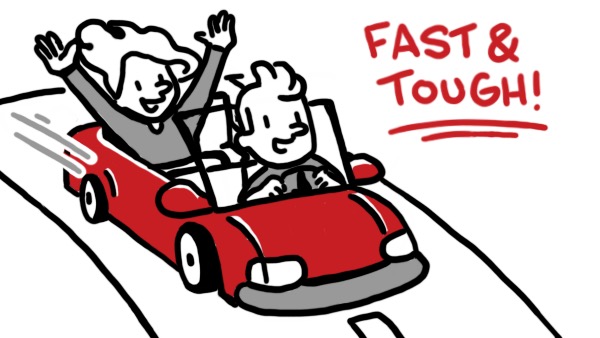Every so often, when I describe my job to someone for the first time, I’ll get a response along the lines of “Whiteboard video? What’s that?” It’s not the kind of question you get in every position (“Auto mechanic? What’s that?” isn’t a common one), but I understand it. It’s a medium that’s not as common as it should be, and it’s natural to be curious.
I usually give a fairly quick explanation and wait for feedback. It tends to range from “Oh, sure, I know what you mean,” to “I don’t really get it—why would someone make that kind of video?” So, here’s an answer to the “why” behind whiteboard for those who aren’t familiar with the approach, as well as for those who might be looking to make a video, but aren’t sure what form it should take—and everyone in between.
We’ll start with the most important things to visualize when trying to accurately imagine whiteboard video: a human hand, holding a dry erase marker, drawing on a whiteboard. And, of course, voiceover—though that’s admittedly not something you can visualize.
Principled Content
TruScribe’s whiteboard videos are made with a set of design principles called Scribology that we’ve discovered and utilize with precision. The first one of these to mention in this early description is the Accent Color. Our whiteboard videos aren’t rainbows of hues—they feature a single Accent Color that draws focus amongst the other black ink drawings.
Okay, there’s the big picture—the ‘what’ of whiteboard. Why should the medium excite you? Why does it keep working so well, across organizations, industries, and countries? Let’s talk specifics.
Collaboration and Audience Engagement
As the client, your whiteboard video will be designed around your script. TruScribe will use a script you create, help you sharpen up a script you’ve started, or work up a full script for you—with your guidance and approval every step of the way. This means that your video is about whatever you need it to be about; whatever your message, your whiteboard video is 100% created to support it.
From your script, whiteboard artists design your visuals for your Approval, progressing through iterations and meeting your needs—all while following the tried and true design principles that spur engagement and drive up retention rates.
These engagement and retention rates are arguably the biggest and best answers to the “why” of whiteboard out there. You need both with any communication, as nobody can act on information they don’t remember (retention), and nobody can remember information that never captured their interest (engagement).
Why is whiteboard the best at enhancing these crucial metrics? The principle of Surprise has taught us that the feeling causes a release of dopamine, making us become and remain curious—i.e., engaged. Every new drawing is a new surprise, so this engagement never slows down. The human hand also drives engagement, because it’s not only a perfect example of the Principle of Motion (causing the eyes to track it around the frame), but a Human Form, which we’re all hardwired to follow.
Retention skyrockets through the powerful employment of the principle of Synchronization between the hand-drawn visuals and voiced script. With both sets of information convening through this synchronization, concepts and representations stay with us long after the video is over.
There are other Principles of Scribology, but we can see already why whiteboard is so successful in transmitting a client’s message. Why else, though, is whiteboard so effective?
Differentiating with Whiteboard
Remember how this entire discussion was predicated on the question of “What is whiteboard video?” The frequency of questions like that means that whiteboard is the absolute opposite of the expected. It’s interesting; it’s human; it’s informative without ever being boring, and it’s fun without being distracting. It’s not another clip-art-styled cartoon, or bubbly computer-generated graphical animation.
It’s far more interesting than a PowerPoint, less expensive than live action, and generally more professional than almost any common business video format. It’s purpose-driven while always being meticulously designed, filmed, and edited, impressing as it informs.
Of course, all of these observations come through comparing whiteboard to other videos. When we compare whiteboard to non-video formats, the differences are even starker. People would almost universally rather watch an engaging video than read a training manual. They would rather watch a whiteboard video than listen to a lecture. Visual storytelling is a wildly popular and effective means of communication, and whiteboard video is a focused, charged dose of this approach.
Unexpected and Lastingly Successful
Cards on the table—it’s understandable that many are underinformed about whiteboard video. We get it. Movies are not made this way, nor is television; it’s natural to assume that moving pictures without the human hand are the only time to use the word ‘animation,’ and that drawing on a whiteboard must be an esoteric way to send a message.
In reality, whiteboard looks both unique and familiar to viewers, using a simple yet engaging setup and vetted design principles to transmit your ideas interestingly and memorably. It’s a medium defined by careful and professional decision-making, every step of the way. It’s the result of a process that depends on partnership and collaboration, fine-tuning each element until the final product is reached.
Why use whiteboard? Because it sends your message, lastingly. Because it’s fun! Because your viewers will remember it—as something not only more engaging than written or spoken instructions, but more professional and straightforward than other business video formats.
And reach out to TruScribe to hear more about why we do what we do. Be sure to ask about Scribology—we love talking about our principles, and how we manage to delight clients again and again with fun, retainable whiteboard videos.

